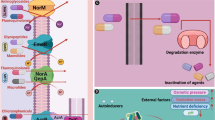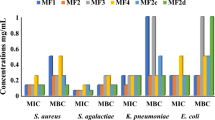Abstract
Antimicrobial peptides are members of the immune system that protect the host from infection. In this study, a potent and structurally novel antimicrobial peptide was isolated and characterized from praying mantis Sphodromantis viridis. This 14-amino acid peptide was purified by RP-HPLC. Tandem mass spectrometry was used for sequencing this peptide, and the results showed that the peptide belongs to the Mastoparan family. The peptide was named Mastoparan-S. Mastoparan-S demonstrated that it has antimicrobial activities against a broad spectrum of microorganisms (Gram-positive and Gram-negative bacteria and fungi), and it was found to be more potent than common antibiotics such as kanamycin. Mastoparan-S showed higher antimicrobial activity against Gram-negative bacteria compared to Gram-positive ones and fungi. The minimum inhibitory concentration (MIC) values of Mastoparan-S are 15.1–28.3 μg/ml for bacterial and 19.3–24.6 μg/ml for fungal pathogens. In addition, this newly described peptide showed low hemolytic activity against human red blood cells. The in vitro cytotoxicity of Mastoparan-S was also evaluated on monolayer of normal human cells (HeLa) by MTT assay, and the results illustrated that Mastoparan-S had significant cytotoxicity at concentrations higher than 40 μg/ml and had no any cytotoxicity at the MIC (−30 μg/ml). The findings of the present study reveal that this newly described peptide can be introduced as an appropriate candidate for treatment of topical infection.
Similar content being viewed by others
References
Bulet, P., Hetru, C., Dimarcq, J.-L., and Hoffmann, D. (1999) Antimicrobial peptides in insects; structure and function, Dev. Comp. Immunol., 23, 329–344.
Irving, P., Troxler, L., and Hetru, C. (2004) Is innate enough? The innate immune response in Drosophila, C. R. Biologies, 327, 557–570.
Tassanakajon, A., Somboonwiwat, K., and Amparyup, P. (2015) Sequence diversity and evolution of antimicrobial peptides in invertebrates, Dev. Comp. Immunol., 48, 324–341.
Tzou, P., De Gregorio, E., and Lemaitre, B. (2002) How Drosophila combats microbial infection: a model to study innate immunity and host-pathogen interactions, Curr. Opin. Microbiol., 5, 102–110.
Yang, J., Furukawa, S., Sagisaka, A., Ishibashi, J., Taniai, K., Shono, T., and Yamakawa, M. (1999) cDNA cloning and gene expression of cecropin D, an antibacterial protein in the silkworm Bombyx mori, Comp. Biochem. Physiol. B, 122, 409–414.
Padhi, A., Sengupta, M., Sengupta, S., Roehm, K. H., and Sonawane, A. (2014) Antimicrobial peptides and proteins in mycobacterial therapy: current status and future prospects, Tuberculosis, 94, 363–373.
Pei, Z., Sun, X., Tang, Y., Zhang, D., Gao, Y., and Ma, H. (2014) Cloning, expression, and purification of a new antimicrobial peptide gene from Musca domestica larva, Gene, 549, 41–45.
Che, Q., Zhou, Y., Yang, H., Li, J., Xu, X., and Lai, R. (2008) A novel antimicrobial peptide from amphibian skin secretions of Odorrana grahami, Peptides, 29, 529–535.
Rollins-Smith, L. A. (2009) The role of amphibian antimicrobial peptides in protection of amphibians from pathogens linked to global amphibian declines, Biochim. Biophys. Acta (Biomembranes), 1788, 1593–1599.
Chen, W., Yang, B., Zhou, H., Sun, L., Dou, J., Qian, H., Huang, W., Mei, Y., and Han, J. (2011) Structure-activity relationships of a snake cathelicidin-related peptide BF-15, Peptides, 32, 2497–2503.
McQuade, R., Roxas, B., Viswanathan, V. K., and Vedantam, G. (2012) Clostridium difficile clinical isolates exhibit variable susceptibility and proteome alterations upon exposure to mammalian cationic antimicrobial peptides, Anaerobe, 18, 614–620.
Nan, Y. H., Lee, S. H., Kim, H. J., and Shin, S. Y. (2010) Mammalian cell toxicity and candidacidal mechanism of Arg- or Lys-containing Trp-rich model antimicrobial peptides and their d-enantiomeric peptides, Peptides, 31, 1826–1831.
Hetru, C. (1994) Antimicrobial Peptides (Boman, H., Marsh, J., and Goode, J. A., eds.) John Wiley & Sons, N. Y.
Brown, M. J. F. (2010) Parasites and insects: aspects of social behavior, in Encyclopedia of Animal Behavior (Breed, M. D., and Moore, J., eds.) Academic Press, Oxford, pp. 632–635.
Erler, S., Lhomme, P., Rasmont, P., and Lattorff, H. M. G. (2014) Rapid evolution of antimicrobial peptide genes in an insect host-social parasite system, Infect. Genet. Evol., 23, 129–137.
Chesnokova, L. S., Slepenkov, S. V., and Witt, S. N. (2004) The insect antimicrobial peptide, l-pyrrhocoricin, binds to and stimulates the ATPase activity of both wild-type and lidless DnaK, FEBS Lett., 565, 65–69.
Li, Y., **ang, Q., Zhang, Q., Huang, Y., and Su, Z. (2012) Overview on the recent study of antimicrobial peptides: origins, functions, relative mechanisms and application, Peptides, 37, 207–215.
Dassanayake, R. S., Silva Gunawardene, Y. I. N., and Tobe, S. S. (2007) Evolutionary selective trends of insect/mosquito antimicrobial defensin peptides containing cysteine-stabilized α/β motifs, Peptides, 28, 62–75.
Ahn, H.-S., Cho, W., Kang, S.-H., Ko, S.-S., Park, M.-S., Cho, H., and Lee, K. H. (2006) Design and synthesis of novel antimicrobial peptides on the basis of α-helical domain of tenecin 1, an insect defensin protein, and structure-activity relationship study, Peptides, 27, 640–648.
Mak, P., Zdybicka-Barabas, A., and Cytrynska, M. (2010) A different repertoire of Galleria mellonella antimicrobial peptides in larvae challenged with bacteria and fungi, Dev. Comp. Immunol., 34, 1129–1136.
Lehrer, R. I., and Ganz, T. (1999) Antimicrobial peptides in mammalian and insect host defence, Curr. Opin. Immunol., 11, 23–27.
Wipfler, B., Wieland, F., DeCarlo, F., and Hornschemeyer, T. (2012) Cephalic morphology of Hymenopus coronatus (Insecta: Mantodea) and its phylogenetic implications, Arthropod Struct. Dev., 41, 87–100.
Hurd, L. E. (2009) Chap. 157. Mantodea: (Praying Mantids), in Encyclopedia of Insects (Resh, V. H., and Carde, R. T., eds.) 2nd Edn., Academic Press, San Diego, pp. 597–599.
Matsuda, R. (1976) 27. The Mantodea, in Morphology and Evolution of the Insect Abdomen (Matsuda, R., ed.) Pergamon, pp. 187–191.
Carle, T., Toh, Y., Yamawaki, Y., Watanabe, H., and Yokohari, F. (2014) The antennal sensilla of the praying mantis Tenodera aridifolia: a new flagellar partition based on the antennal macro-, micro- and ultrastructures, Arthropod Struct. Dev., 43, 103–116.
Popkiewicz, B., and Prete, F. R. (2013) Macroscopic characteristics of the praying mantis electroretinogram, J. Insect Physiol., 59, 812–823.
Koehler, R., and Predel, R. (2010) CAPA-peptides of praying mantids (Mantodea), Peptides, 31, 377–383.
Memarpoor-Yazdi, M., Zare-Zardini, H., and Asoodeh, A. (2013) A novel antimicrobial peptide derived from the insect Paederus dermatitis, Int. J. Pept. Res. Ther., 19, 99–108.
Zardini, H. Z., Amiri, A., Shanbedi, M., Maghrebi, M., and Baniadam, M. (2012) Enhanced antibacterial activity of amino acids-functionalized multi walled carbon nanotubes by a simple method, Colloids Surf. B Biointerfaces, 92, 196–202.
Lupu, A. R., and Popescu, T. (2013) The noncellular reduction of MTT tetrazolium salt by TiO2 nanoparticles and its implications for cytotoxicity assays, Toxicol. in vitro, 27, 1445–1450.
Simmaco, M., Mignogna, G., and Barra, D. (1998) Antimicrobial peptides from amphibian skin: what do they tell us? Biopolymers, 47, 435–450.
McGillivary, G., Ray, W. C., Bevins, C. L., Munson, R. S., Jr., and Bakaletz, L. O. (2007) A member of the cathelicidin family of antimicrobial peptides is produced in the upper airway of the chinchilla and its mRNA expression is altered by common viral and bacterial co-pathogens of otitis media, Mol. Immunol., 44, 2446–2458.
Boman, H. G. (1991) Antibacterial peptides: key components needed in immunity, Cell, 65, 205–207.
Saido-Sakanaka, H., Ishibashi, J., Momotani, E., Amano, F., and Yamakawa, M. (2004) In vitro and in vivo activity of antimicrobial peptides synthesized based on the insect defensin, Peptides, 25, 19–27.
Ho, C. L., and Hwang, L. L. (1991) Structure and biological activities of a new mastoparan isolated from the venom of the hornet Vespa basalis, Biochem. J., 274, 453–450.
Nakajima, T., Yasuhara, T., Uzu, S., Wakamatsu, K., Miyazawa, T., Fukuda, K., and Tsukamoto, Y. (1985) Wasp venom peptides; wasp kinins, new cytotrophic peptide families and their physicochemical properties, Peptides, 6, 425–430.
Ohara-Imaizumi, M., Nakamichi, Y., Ozawa, S., Katsuta, H., Ishida, H., and Nagamatsu, S. (2001) Mastoparan stimulates GABA release from MIN6 cells: relationship between SNARE proteins and mastoparan action, Biochem. Biophys. Res. Commun., 289, 1025–1030.
Wu, T.-M., Chou, T.-C., Ding, Y.-A., and Li, M.-L. (1999) Stimulation of TNF-[agr], IL-1[bgr] and nitrite release from mouse cultured spleen cells and lavaged peritoneal cells by mastoparan-M, Immunol. Cell. Biol., 77, 476–482.
Amin, R. H., Chen, H. Q., Veluthakal, R., Silver, R. B., Li, J., Li, G., and Kowluru, A. (2003) Mastoparan-induced insulin secretion from insulin-secreting βTC3 and INS-1 cells: evidence for its regulation by Rho subfamily of G proteins, Endocrinology, 144, 4508–4518.
Straub, S. G., James, R. F., Dunne, M. J., and Sharp, G. W. (1998) Glucose augmentation of mastoparan-stimulated insulin secretion in rat and human pancreatic islets, Diabetes, 47, 1053–1057.
Yang, M. J., Lin, W.-Y., Lu, K.-H., and Tu, W.-C. (2011) Evaluating antioxidative activities of amino acid substitutions on mastoparan-B, Peptides, 32, 2037–2043.
Mendes, M. A., de Souza, B. M., and Palma, M. S. (2005) Structural and biological characterization of three novel mastoparan peptides from the venom of the neotropical social wasp Protopolybia exigua (Saussure), Toxicon, 45, 101–106.
Ho, C. L., and Hwang, L. L. (1991) Structure and biological activities of a new mastoparan isolated from the venom of the hornet Vespa basalis, Biochem. J., 274, 453–456.
Lee, S. Y., Park, N. G., and Choi, M.-U. (1998) Effects of mastoparan B and its analogs on the phospholipase D activity in L1210 cells, FEBS Lett., 432, 50–54.
Russell, A. L., Kennedy, A. M., Spuches, A. M., Venugopal, D., Bhonsle, J. B., and Hicks, R. P. (2010) Spectroscopic and thermodynamic evidence for antimicrobial peptide membrane selectivity, Chem. Phys. Lipids, 163, 488–497.
Sample, C. J., Hudak, K. E., Barefoot, B. E., Koci, M. D., Wanyonyi, M. S., Abraham, S., Staats, H. F., and Ramsburg, E. A. (2013) A mastoparan-derived peptide has broad-spectrum antiviral activity against enveloped viruses, Peptides, 48, 96–105.
Leal Denis, M. F., Incicco, J. J., Espelt, M. V., Verstraeten, S. V., Pignataro, O. P., Lazarowski, E. R., and Schwarzbaum, P. J. (2013) Kinetics of extracellular ATP in mastoparan 7-activated human erythrocytes, Biochim. Biophys. Acta (General Subjects), 1830, 4692–4707.
Zhang, P., Ray, R., Singh, B. R., and Ray, P. (2013) Mastoparan-7 rescues botulinum toxin-A poisoned neurons in a mouse spinal cord cell culture model, Toxicon, 76, 37–43.
Walsh, E. G., Maher, S., Devocelle, M., O’Brien, P. J., Baird, A. W., and Brayden, D. J. (2011) High content analysis to determine cytotoxicity of the antimicrobial peptide, melittin and selected structural analogs, Peptides, 32, 1764–1773.
Koyama, Y., Motobu, M., Hikosaka, K., Yamada, M., Nakamura, K., Saido-Sakanaka, H., Asaoka, A., Yamakawa, M., Isobe, T., Shimura, K., Kong, C. B., Hayashidani, H., Nakai, Y., and Hirota, Y. (2006) Cytotoxicity and antigenicity of antimicrobial synthesized peptides derived from the beetle Allomyrina dichotoma defensin in mice, Int. Immunopharmacol., 6, 748–753.
Maher, S., and McClean, S. (2006) Investigation of the cytotoxicity of eukaryotic and prokaryotic antimicrobial peptides in intestinal epithelial cells in vitro, Biochem. Pharmacol., 71, 1289–1298.
Dawson, R. M., and Liu, C.-Q. (2011) Analogues of peptide SMAP-29 with comparable antimicrobial potency and reduced cytotoxicity, Int. J. Antimicrob. Agents, 37, 432–437.
Author information
Authors and Affiliations
Corresponding author
Additional information
Published in Russian in Biokhimiya, 2015, Vol. 80, No. 4, pp. 508–516.
Originally published in Biochemistry (Moscow) On-Line Papers in Press, as Manuscript BM14-255, February 15, 2015
Rights and permissions
About this article
Cite this article
Zare-Zardini, H., Taheri-Kafrani, A., Ordooei, M. et al. Identification and biochemical characterization of a new antibacterial and antifungal peptide derived from the insect Sphodromantis viridis . Biochemistry Moscow 80, 433–440 (2015). https://doi.org/10.1134/S0006297915040069
Received:
Revised:
Published:
Issue Date:
DOI: https://doi.org/10.1134/S0006297915040069




